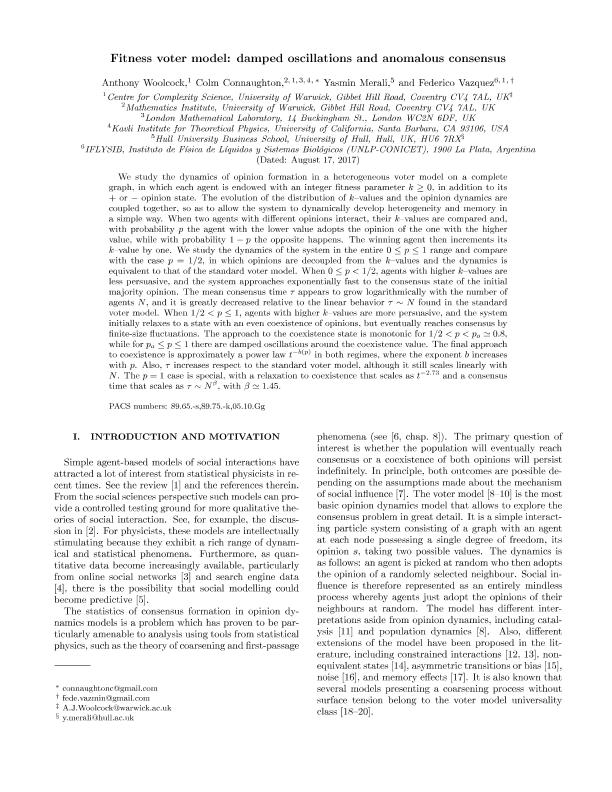Mostrar el registro sencillo del ítem
dc.contributor.author
Woolcock, Anthony
dc.contributor.author
Connaughton, Colm
dc.contributor.author
Merali, Yasmin
dc.contributor.author
Vazquez, Federico

dc.date.available
2018-06-08T18:53:29Z
dc.date.issued
2017-09
dc.identifier.citation
Woolcock, Anthony; Connaughton, Colm; Merali, Yasmin; Vazquez, Federico; Fitness voter model: Damped oscillations and anomalous consensus; American Physical Society; Physical Review E; 96; 3; 9-2017; 1-14
dc.identifier.issn
2470-0045
dc.identifier.uri
http://hdl.handle.net/11336/47941
dc.description.abstract
We study the dynamics of opinion formation in a heterogeneous voter model on a complete graph, in which each agent is endowed with an integer fitness parameter k ≥ 0 , in addition to its + or − opinion state. The evolution of the distribution of k -values and the opinion dynamics are coupled together, so as to allow the system to dynamically develop heterogeneity and memory in a simple way. When two agents with different opinions interact, their k -values are compared, and with probability p the agent with the lower value adopts the opinion of the one with the higher value, while with probability 1 − p the opposite happens. The agent that keeps its opinion (winning agent) increments its k -value by one. We study the dynamics of the system in the entire 0 ≤ p ≤ 1 range and compare with the case p = 1 / 2 , in which opinions are decoupled from the k -values and the dynamics is equivalent to that of the standard voter model. When 0 ≤ p < 1 / 2 , agents with higher k -values are less persuasive, and the system approaches exponentially fast to the consensus state of the initial majority opinion. The mean consensus time τ appears to grow logarithmically with the number of agents N , and it is greatly decreased relative to the linear behavior τ ∼ N found in the standard voter model. When 1 / 2 < p ≤ 1 , agents with higher k -values are more persuasive, and the system initially relaxes to a state with an even coexistence of opinions, but eventually reaches consensus by finite-size fluctuations. The approach to the coexistence state is monotonic for 1 / 2 < p < p o ≃ 0.8 , while for p o ≤ p ≤ 1 there are damped oscillations around the coexistence value. The final approach to coexistence is approximately a power law t − b ( p ) in both regimes, where the exponent b increases with p . Also, τ increases respect to the standard voter model, although it still scales linearly with N . The p = 1 case is special, with a relaxation to coexistence that scales as t − 2.73 and a consensus time that scales as τ ∼ N β , with β ≃ 1.45 .
dc.format
application/pdf
dc.language.iso
eng
dc.publisher
American Physical Society

dc.rights
info:eu-repo/semantics/openAccess
dc.rights.uri
https://creativecommons.org/licenses/by-nc-sa/2.5/ar/
dc.subject
Opinion Formation
dc.subject
Heterogeneous Voter Model
dc.subject
Stochastic Process
dc.subject
Intrinsic Fitness
dc.subject.classification
Otras Ciencias Físicas

dc.subject.classification
Ciencias Físicas

dc.subject.classification
CIENCIAS NATURALES Y EXACTAS

dc.title
Fitness voter model: Damped oscillations and anomalous consensus
dc.type
info:eu-repo/semantics/article
dc.type
info:ar-repo/semantics/artículo
dc.type
info:eu-repo/semantics/publishedVersion
dc.date.updated
2018-06-08T14:28:14Z
dc.journal.volume
96
dc.journal.number
3
dc.journal.pagination
1-14
dc.journal.pais
Estados Unidos

dc.description.fil
Fil: Woolcock, Anthony. University of Warwick; Reino Unido
dc.description.fil
Fil: Connaughton, Colm. University of Warwick; Reino Unido. London Mathematical Laboratory; Reino Unido. University of California; Estados Unidos
dc.description.fil
Fil: Merali, Yasmin. University of Hull; Reino Unido
dc.description.fil
Fil: Vazquez, Federico. University of Warwick; Reino Unido. Consejo Nacional de Investigaciones Científicas y Técnicas. Centro Científico Tecnológico Conicet - La Plata. Instituto de Física de Líquidos y Sistemas Biológicos. Universidad Nacional de La Plata. Facultad de Ciencias Exactas. Instituto de Física de Líquidos y Sistemas Biológicos; Argentina
dc.journal.title
Physical Review E
dc.relation.alternativeid
info:eu-repo/semantics/altIdentifier/doi/https://dx.doi.org/10.1103/PhysRevE.96.032313
dc.relation.alternativeid
info:eu-repo/semantics/altIdentifier/url/https://journals.aps.org/pre/abstract/10.1103/PhysRevE.96.032313
Archivos asociados
